.....When I was learning how to play
pool there were no books, no videos, no instructors and no leagues
to play in. The best way to learn was to watch. I was privileged
to see some of the greatest and some of the not so great. My
purpose for publishing my pointers insrtuctional column is not
only to inpart pool knowledge to my viewers but to share with the
public what these great players from the 1980s and 1990s looked
like. Through my trusty Canon, for a moment in time they are immortalized.
Some are still here and some are gone and I still remember the
joy of watching them play.

TRYING TO GET OVER?
Use These Simple Techniques To Shoot Over A Ball
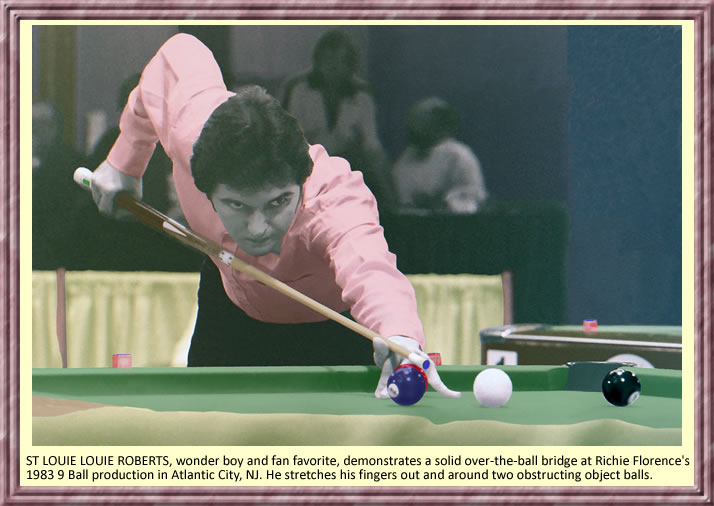
.....A DAUNTING PROBLEM that faces many a beginner and intermediate player is when the cue ball is touching or very close to an object ball that lies behind it. This is when the over-the-ball bridge, as demonstrated above by Louie Roberts, should be used. This hand bridge is very similar to the open bridge, except that the palm of the hand is raised up off the table. By the way, Louie, who hails from St Louis, MO was a talented high rolling pool player who personified the exciting and intriguing side of money stakes games that the public is fascinated by. Diamond Billiard Products and the Derby City Classic (DCC) proudly celebrate that tradition with their annual Louis Roberts Action/Entertainment Award. Attendants of the DCC event vote on who personifies Louie's entertainment panache and the pool player who receives the most votes receives a free life-time entry into the tournament. Read more about this exciting tribute to a fallen hero at http://www.onepocket.org/LouieRobertsAward2011.htm. But dear reader, I digress…
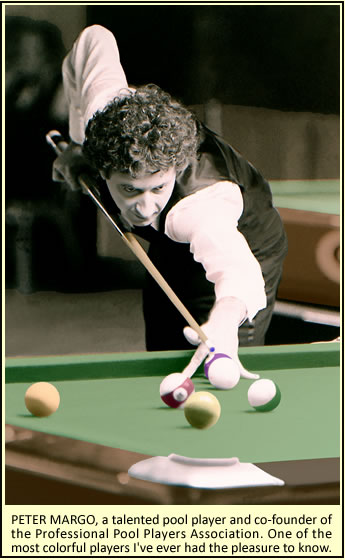
.....When making the over-the-ball hand bridge, the thumb and knuckle of your index finger must form the same V-shape fashioned when making an open bridge hand. Look at the definition World Open player Pete Margo (Read more about Pete) has in his V-shaped hand bridge. One can clearly see how the finger contour is an aid in directing the cue ball. Raise your hand up so that you’re on the tips of your fingers with the palm and heal of your hand facing the table. Your hand looks like an upside down ‘L’. Usually men have large hands. When they utilize the over the ball bridge they stretch their fingers out and around the impeding ball. However, if you have a smaller sized hand the pointers given in this thesis will help in overcoming this formidable situation. Be sure to keep the palm of your hand facing the table. Believe it or not, the lower the heal of your hand gets, the more height you’ll get on the V-shape finger where the stick sits. Most beginners will raise up the back of their hand. That action would give you more height but you lose the capacity to form the V shape for your stick. It makes for a weak bridge.
.....Lightly place your fingers on the pool table. Don’t press down hard on your fingers. This is the biggest mistake beginner players make in that they press down too hard or lean back on their fingers. If you do this you’ll lose height making it more difficult to shoot over the ball.
,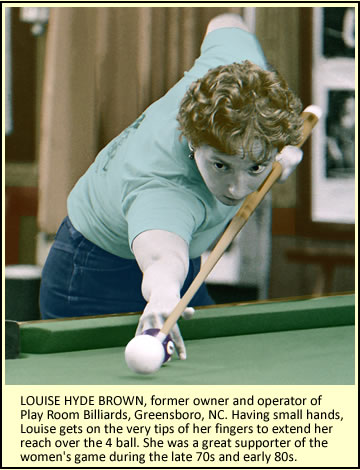 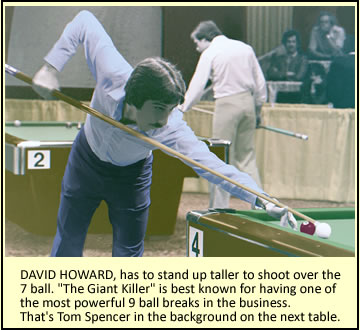
.... When you shoot over a ball you need to make your stance higher. Dave Howard stands taller in order to shoot over the 7 ball at an Atlantic City event. Standing up straighter helps you to sight the cue ball over the impending object ball, as well as, giving you more height to shoot over something. Louise Hyde Brown is about 5’ 3” so she places her feet closer together rather than getting into her regular shooting stance. This pose automatically gives her more height.
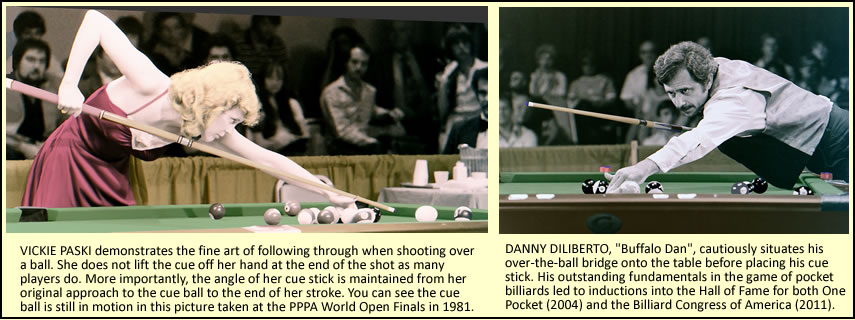
.....I also stress that you should form the over-the-ball bridge in front of the obstructing object ball before you place your cue stick on top of your fingers. If you accidentally touch the obstructing ball and it rolls into the cue ball it is a foul in any pool game you play. Sometimes it is a foul if you touch the object ball itself. This is called, “playing all fouls”. For insurance against fouls, place your hand bridge first before placing your stick. Not only does this prevent you from touching an object ball, but it helps with your aim. Since your stick is resting on the V-shape you can line that sight up before placing your stick. Make slight adjustments to your aim later. Here, Danny DiLiberito during the finals of the 1982 World Open carefully sets his hand on the table before placing his cue stick. Allen Hopkins is trying to bridge over several object balls. He cautiously puts his hand down first allowing him to get as close as possible to the obstructing balls without touching anything. By getting close to the Impeding ball you get more height. By getting more height you receive more options for striking the cue ball high, middle or low.
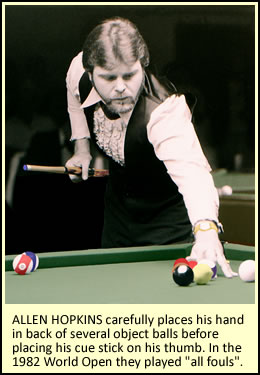
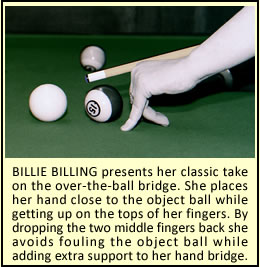 .....I recommend that you tuck your ring and middle fingers back to form a tripod-like shape to prevent touching an object ball and to give extra stability to your bridge hand. I use this hand bridge technique and teach it to my students. .....I recommend that you tuck your ring and middle fingers back to form a tripod-like shape to prevent touching an object ball and to give extra stability to your bridge hand. I use this hand bridge technique and teach it to my students.
.....Once you are satisfied with the angle of the cue stick and its approach to the cue ball, follow through on the same trajectory angle. Vickie Paski, at the 1981 World Open, has just followed through on her shot and maintains her straight line. Notice that she does not lift up the stick during her follow through.
.....When you keep making the over the ball bridge (or any bridge for that matter), eventually your fingers become more malleable making it easier to form the various hand bridges. In order to become more nimble keep practicing!
 . .

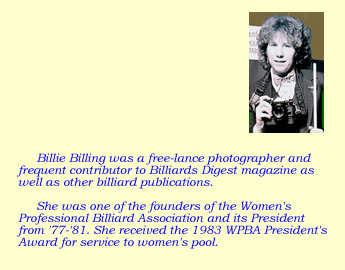
.....
Pool Pointer Archives
.....1. Closed Half-Bridge
... .2. Look Before You Leap
.....3. Mechanically Inclined
.....4. Keep A Level Cue
.....5. Double or Nothing
.....6. Chalk It Up
.....7. V-Bridge It To Victory
.....8. The Right Combination
.....9. Referees; Unsung heros
...10. Don't Lag Behind
...11. Tongue Twister; Mouth Pool
...12. Read The Right Angle
...13. Don't Let Your Draw Stroke Be a Drawback
...14. Under and Over
...15. Kangaroos & Big Pockets
...16. Find The Path To The Contact Point
...16. Trying To Get Over?
.....Tune
in for more Pointer articles coming
your way each month.

|

